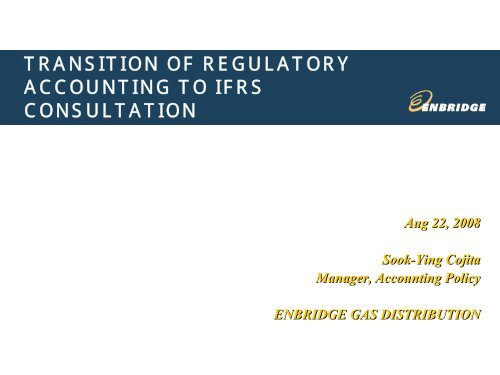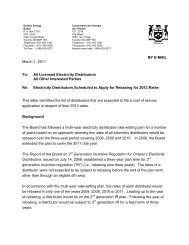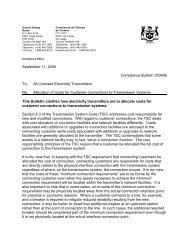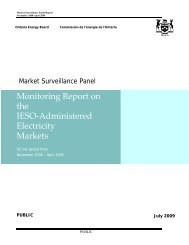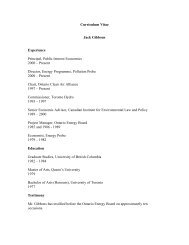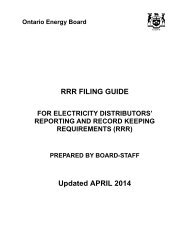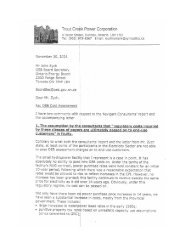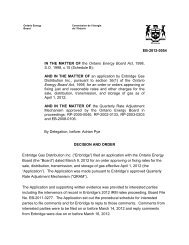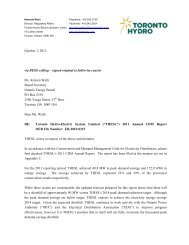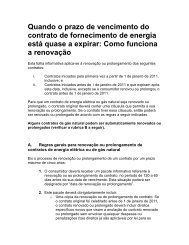Enbridge Gas Distribution Inc. Presentation - Ontario Energy Board
Enbridge Gas Distribution Inc. Presentation - Ontario Energy Board
Enbridge Gas Distribution Inc. Presentation - Ontario Energy Board
You also want an ePaper? Increase the reach of your titles
YUMPU automatically turns print PDFs into web optimized ePapers that Google loves.
TRANSITION OF REGULATORYACCOUNTING TO IFRSCONSULTATIONAug 22, 2008Sook-Ying CojitaManager, Accounting PolicyENBRIDGE GAS DISTRIBUTION
Agenda1. Plan for review & adoption of IFRS2. EGD IFRS status & outlook3. Developments at CICA & IASB4. Key IFRS vs. CDN GAAP differences5. IFRS resourcing & training6. Potential regulatory impacts7. Future use of deferral & variance accounts8. Revisions to Uniform System of Accounts &Accounting Procedures Handbook2
Plan for review & adoption of IFRS• Project Team– Established IFRS Core Team & committees across <strong>Enbridge</strong> enterprise:• Financial reporting & system specialists across BUs and corporate office• Committees/ contacts for specific areas: eg. PP&E, inventory, rateregulated accounting, etc.• Weekly team meetings/ calls & committee meetings as required• Plan1. Research & document key IFRS vs. CDN GAAP differences and key impacts2. Identification of key mini-projects for implementation3. Assessments and implementation of financial reporting impacts & systemchanges4. Assessments & integration of changes to other business processes (eg. budgets& planning, internal reporting, tax, rate setting & recovery, etc.)5. Training6. Implementation to F/S, disclosures, controls, policies & procedures, etc.7. Testing of new processes and systems3
EGD IFRS Status & Outlook• 2008– Identification & documentation of IFRS vs CDN GAAP differences– Key projects identification and assessments– System impact assessments & planning– Review impacts to other business processes• 2009– Completion of significant projects– Obtain acceptance of position papers from external auditors– Continue & complete work on system changes– Complete review of impacts on other business processes– High level financial disclosures– Start roll out of training across organization• 2010– Preparation of detailed F/S disclosures– Complete training on IFRS changes across organization– Complete IFRS implementation: F/S, disclosures, systems, procedures & policies, controls• 2011– Jan 1, 2011 – Reporting using IFRS - F/S, disclosures, systems, procedures & policies, controlsOngoing: monitoring IFRS developments and changes4
Developments at CICA & IASBAwaiting following potential decisions from IASB:• Potential exemption from restating PP&E on adoption:• Strongly supported by <strong>Enbridge</strong>• Restatement is a significant challenge (if not an impossibility) for a 160 year-oldentity• Back-up plan: work with 1994 acquisition* values as FV and apply IFRSguidance from thereon.• Ability to recognize regulatory assets and liabilities• Strongly supported by <strong>Enbridge</strong>• Better represent economic realities of the business• Prevent volatility in earnings that will otherwise result from changes in gas pricesand other factors• Back-up plan is to significantly elaborate MD&A disclosures with enhanced focuson non-GAAP measures reported, within the bounds of securities regulation* Note: <strong>Enbridge</strong> <strong>Inc</strong>. acquired EGD (formerly Consumers <strong>Gas</strong> Co.) in 1994 in an arms-lengthtransaction5
Key IFRS vs. CDN GAAP differences• Key Areas Impacted:*I. Regulatory Assets & LiabilitiesII.Property, Plant & EquipmentIII.Inventory• * This is not intended to be an exhaustive list, but attempts to highlight thesignificant areas impacting <strong>Enbridge</strong>6
Regulatory Assets & Liabilities• IFRS Guidance:– All assets and liabilities are required to meet asset and liability definitionsunder IFRS in order to be recognized– No special recognition provisions for regulatory assets or liabilities underIFRS• Impacts:– Some or all regulatory assets & liabilities would not be recognized underIFRS– Significant volatility in earnings:• Eg. EGD gas price variance payable/ receivable not recognizable in F/S wouldresult in following inclusion in after-tax earnings:– $8.8M (2007)– $99.3M (2006)– Regulatory assets and liabilities that no longer qualify for recognition wouldbe derecognized through retained earnings• Developments:– Awaiting developments/ decisions from IASB on regulatory assets andliabilities7
Property, Plant & EquipmentMajor PP&E impacts:• Valuation upon adoption• CGU (Cash Generating Unit) identification• Componentization• Recognition & De-recognition• Decommissioning costs• Impairments• Overhead Capitalization8
Valuation Upon Adoption of IFRS• IFRS Guidance:– PPE measured at cost, with first time adoption exemption (IFRS 1) foralternative valuations as follows:• Fair value at date of transition to IFRS• Revaluation under a previous GAAP before transition to IFRS• Deemed cost previously established using fair value at particular eventdate• Impacts:– EGD required to determine most feasible option for valuation– EGD’s current cost is essentially its rate base, which is not fullyconsistent with IFRS definition of cost– Fair value alternatives pose challenges – eg. Recreation of records fordepreciation, overhead, etc.• Developments:– Awaiting decision from IASB that may allow rate regulated entities touse rate base as historical cost on transition to IFRS without furtheradjustments9
Inventory• IFRS Guidance:– Inventories to be measured at the lower of cost and netrealizable value (NRV).– Storage costs, unless necessary in production process,should be excluded from costs of inventory.• Impacts:– Biggest impact for EGD: gas inventory, which is valued todayat regulatory reference price– Volatility in earnings expected given differences in valuationsbetween regulatory and IFRS valuation10
IFRS Resourcing and TrainingResources:• Project held by personnel with prior financial reportingresponsibilities• Participation of specialists from various operating groups• Engaged Deloitte & Touche as consultantsTraining:• Project personnel:– External courses and seminars– Research activities– Consultation with Deloitte & Touche• Other personnel:– In-house IFRS update sessions11
Potential Regulatory ImpactsRegulatory Reporting Impacts:• Largely dependent on resolution on regulatory assets & liabilitiesand PP&E• Potential scenario: multiple sets of books• Requirement to determine relationship between IFRS balancesheet and rate-base calculationsHigher costs and resources required:• Establishing & maintaining multiple sets of books• Impact on cost of capital (financial covenants, coverage ratios)12
Future use of Deferral & Varianceaccounts• Regulatory Assets & Liabilities– Critical deferral & variance accounts need to continue tobe tracked for rate-setting purposes, irrespective ofIFRS treatment– Require to assess feasibility of achieving congruencebetween rate-setting and IFRS treatment of non-criticalaccounts– Potential outcome: multiple sets of books13
Uniform System of Accounts &Accounting Procedures HandbookWill OEB allow/ propose changes to US of A & AccountingProcedures Handbook?– Sample areas affected:• Regulatory Assets & Liabilities– not permitted under IFRS (unless exemption received)• PP&E changes:– Componentization (potential additional accounts)– Capitalization policy (being different under IFRS)– Impairments• Inventory:– Valuation at lower of cost and NRV, and corresponding valuationadjustments14
Questions&Comments?15


